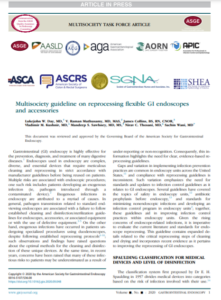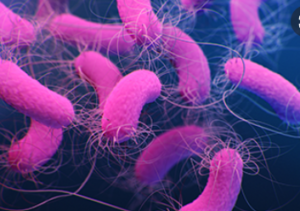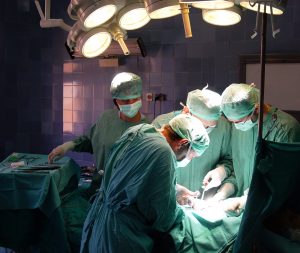Highlight: Studies dating back a few decades indicate that the addition of an alcohol flushing step prior to forced-air drying of the flexible endoscope’s internal channel can more effectively prevent microbial contamination of the endoscope than forced air drying alone. A few of these studies reported that both the drying and biocidal properties of alcohol are likely responsible for these findings.
February 21, 2022 (by: Lawrence F Muscarella, PhD) – An updated guideline published last year raises some questions about a common practice that endoscopy departments have been performing for years to prevent infections of potentially infectious microorganisms, particularly bacteria that can reside in water and grow rapidly on moist surfaces.
Like three earlier versions of the guideline published in 2003, 2011 and 2017, this newly issued 2021 guideline provides updated guidance for the present-day reprocessing of flexible gastrointestinal endoscopes and accessories.
For example, while reiterating several recommendations published in these three earlier versions, this 2021 guideline discusses some new and current topics including the use of single-use duodenoscopes and reprocessing GI endoscopes during the COVID-19 pandemic.
Studies dating back a few decades indicate that the addition of an alcohol flushing step prior to forced-air drying of the endoscope’s internal channel can more effectively prevent microbial contamination of the endoscope than forced air drying alone. — Lawrence F. Muscarella, Ph.D.
Endoscope reprocessing is a multi-stepped process that centers around the cleaning and either high-level disinfection or sterilization of a flexible endoscope. This process removes and destroys microorganisms and viruses that contaminated the device during clinical use, rendering the endoscope “patient ready” and safe for reuse.
The types of organisms that can contaminate a flexible endoscope during clinical use, and pose an infection risk, include carbapenem-resistant Enterobacteriaceae and other multidrug-resistant bacteria.
Effective reprocessing also prevents environmental organisms from re-contaminating the device after disinfection or sterilization and prior to reuse.  To mitigate this potential infection risk, published guidelines recommend that, among other measures, the water used to rinse the endoscope’s surfaces terminally after chemical immersion be filtered (i.e., bacteria-free), and ideally sterile.
To mitigate this potential infection risk, published guidelines recommend that, among other measures, the water used to rinse the endoscope’s surfaces terminally after chemical immersion be filtered (i.e., bacteria-free), and ideally sterile.
Thoroughly rinsing the endoscope terminally with water is necessary to remove residues of the chemicals used during reprocessing that can be potentially toxic to a patient’s tissues and mucosa.
Pseudomonas aeruginosa and other gram-negative bacteria are examples of the types of infectious organisms that can reside in tap water, re-contaminate the disinfected endoscope during water rinsing, and proliferate in a flexible endoscope’s wet internal channels. Like P. aeruginosa, nontuberculous mycobacteria such as Mycobacterium chelonae may also be found in tap water.
Other reprocessing steps include pre-cleaning the GI endoscope immediately after the endoscopic procedure to prevent bioburden from hardening and becoming too difficult to remove with a cleaning brush, and leak testing the endoscope before more thorough and complete reprocessing.
As manufacturer instructions advise and guidelines re-emphasize, failure to perform each endoscope reprocessing step properly can pose a significant risk of patient infection with associated morbidity and mortality. According to the federal Centers for Disease Control and Prevention (CDC), more healthcare–associated outbreaks have been linked to flexible endoscopes than to any other type of medical device.
This new “multisociety” guideline issued last year, like each of its three earlier versions released beginning in 2003, was endorsed by several collaborating organizations specializing in gastroenterology, infection prevention, surgery, and epidemiology.
Featuring several long and narrow internal channels, a GI endoscope is a type of flexible endoscope used to examine, diagnose and treat disorders of the upper and lower GI tracts.
Consulting Services, Expert Guidance and Case Reviews: LFM-Healthcare Solutions, LLC provides medical expertise for hospitals, manufacturers and the public, specializing in healthcare-associated infections linked to contaminated reusable medical equipment. Value oriented with years of experience.
Endoscope drying
Drying all of the flexible endoscope’s external surfaces and internal channels terminally, after water rinsing, is another reprocessing step whose contribution to the prevention of disease transmission is well documented. Endoscope drying may be achieved using forced, pressure-regulated filtered (medical or instrument) air.
Underscoring the measure’s importance to patient safety, the CDC advised in a 2008 guideline that forced-air drying “markedly reduces bacterial contamination of stored endoscopes, most likely by removing the wet environment favorable for bacterial growth.”
The Society for Gastroenterology Nurses and Associates (SGNA) published similar guidance ten years later, adding that thorough drying along with proper storage of the endoscope is “as important to the prevention of disease transmission and nosocomial infection as cleaning and (high-level disinfection).”
Water remaining on the disinfected endoscope’s surfaces, particularly in its internal channels due to incomplete or ineffective drying, can promote the rapid proliferation of microorganisms and facilitate the formation of biofilms that may be challenging to remove during cleaning and to eradicate during disinfection.
Once firmly established on the endoscope’s surface, a biofilm’s organisms can become a persistent source of bacteria and, in turn, infections. In addition to ineffective drying, risk factors for biofilms forming on endoscope surfaces include inadequate cleaning, endoscope damage, and a faulty endoscope component (e.g., a loosen biopsy port).
Despite the importance of endoscope drying to prevent bacterial transmissions, however, published guidelines may not always provide clear guidance to healthcare providers about precisely how to dry the endoscope’s internal surfaces and each of its internal channels, although a recent study investigated optimal strategies for drying different types of GI endoscopes. Reports suggest that drying the endoscope’s channels may require at least 10 minutes.
Several reports link the incomplete drying of a flexible endoscope to multiple outbreaks of waterborne microorganisms including P. aeruginosa and atypical mycobacteria. Published cases also link outbreaks of CRE to the improper drying and storage of a duodenoscope.
One study reported improper drying to be associated with an endoscope contamination rate of as high as 80%. Guidelines recommend that reprocessed, dried endoscopes be stored in accordance with the manufacturer’s instructions to prevent the device’s re-contamination prior to reuse.
Alcohol to facilitate drying
Adoption of “best practices” documented to reduce the risk of endoscope-related infections is crucial to public health.
The proper execution and oversight of these practices is imperative not only in today’s world of advancing antimicrobial resistance and emerging novel respiratory viruses, but also to terminate identified outbreaks of CRE and other multidrug-resistant bacteria linked to ineffectively reprocessed flexible endoscopes.
In the past, reports have advised flushing the internal channels of reprocessed flexible endoscopes with 70-90% ethyl or isopropyl alcohol, prior to forced air, to facilitate the drying process.
For example, following the publication of cases several years ago describing true and pseudo-infections linked to contaminated GI endoscopes and bronchoscopes, an endoscope manufacturer issued an alert, in 1990, recommending that all of the endoscope’s internal channels be rinsed with 70% isopropyl alcohol and suctioned with forced air after use of an automated endoscope reprocessor (“AER”).
Discussing this alert and drying recommendation, it is acknowledged that CDC stated the next year, in 1991, that the terminal alcohol rinsing of endoscopes followed by forced-air drying “has not been rigorously evaluated and does not ensure elimination of microbial contamination originating from the (AER).”
Almost 20 years later in its aforementioned 2008 guideline, however, the CDC provided guidance similar to this manufacturer’s 1990 alert, recommended flushing a flexible endoscope’s internal channels with 70-90% ethyl or isopropyl alcohol, followed by forced air, “to reduce the likelihood of contamination of the endoscope by waterborne pathogens and to facilitate drying.”
In order to ensure that endoscopes are thoroughly dried, they must be flushed with 70% to 90% ethyl or isopropyl alcohol prior to being dried with pressurized, filtered air either by AER or manually. — Society of Gastroenterology Nurses and Associates (SGNA), 2018
CDC further noted in that 2008 guideline, in the context of rinsing the endoscope with water after chemical immersion, that “no evidence of disease transmission has been found when a tap water rinse is followed by an alcohol rinse and forced-air drying.”
Echoing similar advice, SGNA advised in its aforementioned 2018 guideline that: “In order to ensure that endoscopes are thoroughly dried, they must be flushed with 70% to 90% ethyl or isopropyl alcohol prior to being dried with pressurized, filtered air either by AER or manually.”
SGNA clarified in that 2018 guideline that alcohol flushed through the endoscope “displaces water and evaporates more easily than water,” and that alcohol “mixes with the remaining water on the channel surfaces and encourages evaporation of the residual water as air flows through the channel.”
As recently as last year, FDA advised that high-level disinfection (at least of bronchoscopes) should include, after the chemical immersion step, “rinsing with tap or utility water followed by alcohol flushing or with critical (filtered or sterile) water, and drying.”
Concentrations of ethyl or isopropyl alcohol in the range of 70-90% are generally indicated for this drying application. Unlike 100% alcohol solutions, these lower concentrations also contain water, which slows the alcohol’s evaporation and enhances effectiveness.
The newly issued “multisociety” 2021 guideline
These recommendations to flush the endoscope’s internal surfaces with alcohol to facilitate drying and reduce the contamination risk notwithstanding, the updated “multisociety” guideline published in January 2021 raises some questions about the merit of this practice.

To be clear, this 2021 guideline does not doubt — indeed it emphasizes — the importance of drying the endoscope terminally, after water rinsing, using a clean, lint-free cloth for the endoscope’s exterior surfaces and forced air for the endoscope’s internal channels inaccessible to physical wiping.
However, while acknowledging that alcohol not only promotes the “evaporation of residual water within endoscope channels, thereby reducing the potential for bioburden buildup,” but also has “intrinsic antimicrobial properties,” this 2021 guideline questions whether the current evidence supporting the use of alcohol flushes for drying endoscopes is sufficiently convincing to promote the practice.
Due to this guideline’s uncertainty, it instead advises that facilities refer to and follow the endoscope manufacturer’s reprocessing instructions for guidance on the use of ethyl or isopropyl alcohol for drying endoscopes.
Notably, a few other guidelines also may not emphasize the routine use of an alcohol rinse to facilitate endoscope drying. Such a stance is reasonably contrasted, however, with the recommendations of the aforementioned 2008 CDC guideline and SGNA’s 2018 guideline, among other guidelines and reports, endorsing adoption of this two-step process. Factors that may contribute to this apparent disparity in guidelines vis-à-vis the use of alcohol for drying is not entirely clear.
Moreover, this 2021 guideline’s stance differs in emphasis from the recommendations provided in this guideline’s three earlier precursors published in 2003, 2011 and 2017, each of which advised that the endoscope be flushed with 70-90% ethyl or isopropyl alcohol followed by the forced-air drying step to reduce the possibility of recontamination of the endoscope by waterborne microorganisms.
Almost 15 years ago, Muscarella (2006) reviewed several different endoscope reprocessing guidelines, noting some inconsistencies among the guidelines with regard to endoscope drying .
What do the published data say?
The medical literature was reviewed, including outbreak investigations conducted during the past 40 years involving contaminated endoscopes, to provide additional insight on this topic.
More specifically, published data were reviewed in an attempt to address apparent disparities in guidelines and assess whether flushing the internal channels of a flexible endoscope, particularly a GI endoscope, with 70% alcohol prior to the terminal forced-air-drying step has been documented to improve patient safety — for example, to terminate an encountered outbreak.
In short, this review identified studies reporting that this two-step process involving alcohol, in contrast to just drying the endoscope using only forced air, can enhance drying and reduce the risk of the endoscope’s contamination and transmission of diseases.
This review identified studies reporting that 70% alcohol followed by forced air drying — in contrast to drying the endoscope using only forced air — can enhance drying and reduce the risk of the endoscope’s contamination and transmission of diseases. — Lawrence F. Muscarella, Ph.D.

Allen et al. (1987), for example, traced an outbreak of P. aeruginosa to a contaminated duodenoscope. Despite repeatedly reprocessing the endoscope using an AER, viable bacteria remained in the duodenoscope’s moist internal channels after the final water rinsing step, according to these investigators.
Even though they then began using suctioned air to dry the endoscope and prevent infection, Allen et al. (1987) continued to culture P. aeruginosa from the duodenoscope. These investigators reported, however, that contamination of the endoscope “ended only after we began to manually suction alcohol through the endoscope before air drying.”
Duodenoscopes are a complex type of GI endoscope used to during endoscopic retrograde cholangiopancreatography (ERCP) to diagnose and treat diseases, including cancers and obstructions, in the pancreatic and biliary ducts.
Four years later, Alvarado et al. (1991) reported a significant increase in the number of P. aeruginosa infections and colonizations following patient exposure to upper GI endoscopes including duodenoscopes after using a recently purchased AER.
Similar to Allen et al.’s (1987) findings, Alvarado et al. (1991) reported that only by terminally rinsing the endoscope’s channels and external surfaces with 70% isopropyl alcohol, followed by forced air drying, “has reliable disinfection (of the endoscopes) been achieved.”
Alvarado et al. (1991) further noted that the addition of this alcohol rinse and forced air drying step — which they termed a “simple but highly effective measure” — “totally eliminates P. aeruginosa and other gram-negative bacillary contamination” remaining on the endoscope after use of the AER. According to these investigators, this AER featured a design flaw that interfered with the endoscope’s effectiveness.
Two year later, Struelens et al. (1993) described an outbreak of P. aeruginosa and Enterobacteriaceae linked to contaminated duodenoscopes also reprocessed using an AER. These investigators similarly reported that effective disinfection of the endoscope included the addition of isopropanol-air flushing of all of the endoscope’s channels.
In 1999, Kovacs et al. (1999) published the findings of a simulated-use study using GI endoscopes contaminated with M. chelonae to assess the adequacy of current reprocessing practices. These investigators found that high-level disinfection of manually cleaned GI endoscopes immersed in 2% (alkaline) glutaraldehyde for 10, 20, or 45 minutes (at room temperature) was achieved only by the addition of a 70% isopropanol alcohol rinse (and endoscope drying).
Based on these results, Kovacs et al. (1999) concluded that alcohol rinsing is “a valuable adjunctive step for drying and for its bactericidal effects.” Studies have found similar results when 70% alcohol was used to facilitate the terminal drying of other types of flexible endoscopes, including bronchoscopes.
Fraser et al. (1992), for example, reported a pseudo-outbreak of M. chelonae (subspecies abscessus) linked to bronchoscopes disinfected using an AER. In response to these cases, the facility adopted several “aggressive” infection control measures including using sterile water during the AER’s rinse cycle and increasing the disinfection cycle’s exposure time.
Nevertheless, these investigators reported that “the epidemic strain of M. chelonae continued to be isolated from bronchoscopy specimens.” Only once the facility initiated a 70% alcohol rinse prior to the forced air drying of the department’s bronchoscopes were no further isolates of the M. chelonae epidemic strain identified during the following 17 months of surveillance. (This report acknowledges that a non-epidemic strain of M. chelonae was isolated from bronchoscopy specimens despite adoption of the alcohol rinse, suggesting this measure may not be foolproof.)
Like Fraser et al. (1992), Wang et al. (1995) reported an unusual increase in the number of patient bronchial washing specimens contaminated with M. chelonae. These investigators found that the suction channel of four bronchoscopes was contaminated with the mycobacteria despite disinfection using an AER.
In response, Wang et al. (1995) reported modifying the bronchoscope disinfection procedure to include “extensive suctioning and rinsing of the suction channel with 70% alcohol” immediately following automated disinfection. According to these investigators, this additional measure terminated the facility’s pseudo-outbreak and “no additional episodes of cross-contamination or infection have occurred.”
Hoffmann et al. (1989) reported a pseudo-outbreak of Rhodotorula rubra also linked to bronchoscopy. An investigation found that two brushes used to clean the bronchoscope were contaminated with the yeast, as also was the water in the basin used to leak test the bronchoscope.
To stop this pseudo-outbreak, the facility instituted a number of control measures including the complete air drying of the bronchoscopes before storage (as well as high-level disinfection of the reusable brushes used to clean the bronchoscopes). Nevertheless, Hoffmann et al. (1989) reported an additional yeast case one month later. This pseudo-outbreak ended once the facility additionally began rinsing the bronchoscopes with 70% ethyl alcohol immediately prior to storage.
These reviewed studies reporting the contribution of an alcohol-flushing step, prior to drying the endoscope, to the prevention of contamination noted that the endoscope was being disinfected using an AER. Whether reprocessing the flexible endoscopes manually instead would have yielded similar results is unclear, but can be reasonably expected.
Scientific Affairs, Expert Guidance and Case Reviews: LFM-Healthcare Solutions, LLC provides medical expertise for hospitals, manufacturers and the public, specializing in healthcare-associated infections linked to contaminated reusable medical equipment. Value oriented with years of experience.
Recommendations, Summary
Studies dating back a few decades indicate that the addition of an alcohol flushing step prior to forced-air drying of the endoscope’s internal channel can more effectively prevent microbial contamination of the endoscope than forced air drying alone. A few of these studies reported that both the drying and biocidal properties of alcohol are likely responsible for these findings.
This review acknowledges that not all guidelines agree and necessarily promote with similar emphasis this two-step practice. In fact, some reports caution that alcohol has “protein fixation properties that could lead to the retention of organisms within the endoscope” and potentially pose an increased infection risk.
 Nevertheless, this review did not identify any data demonstrating that use of an alcohol rinse prior to forced-air drying provided no clinical benefit compared to forced air drying alone. Nor did this review identify any clinical data directly linking use of an alcohol rinse to an infection either through the fixation of proteins on the endoscope’s surface or otherwise.
Nevertheless, this review did not identify any data demonstrating that use of an alcohol rinse prior to forced-air drying provided no clinical benefit compared to forced air drying alone. Nor did this review identify any clinical data directly linking use of an alcohol rinse to an infection either through the fixation of proteins on the endoscope’s surface or otherwise.
Based primarily on this article’s review of the published data, the following recommendations are provided with a focus on increasing the safety of duodenoscopes and bronchoscopes:
- Meticulously clean and high-level disinfect, or sterilize, the flexible endoscope in accordance with manufacturer’s instructions and published guidelines.
- The periodic review of published endoscope reprocessing guidelines, including those published by SGNA and others discussed in this article, is encouraged to ensure proper training and staff competency.
- FDA guidance for the sterilization of semi-critical devices such as flexible endoscopes can be downloaded and read here.
- Rinse the flexible endoscope after chemical immersion using a validated process that uses copious amounts of bacteria-free, or ideally sterile, water consistent with manufacturer instructions.
- After water rinsing, this article recommends flushing the endoscope’s channels with medical-grade 70-90% ethyl or isopropyl alcohol followed by forced-air, consistent with the endoscope manufacturer’s instructions and published clinical studies, to facilitate drying and reduce the risk of contamination of the endoscope with waterborne bacteria. (It is acknowledged that not all guidelines agree with this recommendation.)
- These dying steps are recommended after each reprocessing cycle (especially before storage), whether using an AER or reprocessing the endoscope manually.
- Data suggest that newly designed AERs are considerably less susceptible to colonization with waterborne bacteria, compared to older recalled AER models implicated years ago (e.g., in the 1990s) during true- and pseudo-outbreak investigations. Use and servicing of the AER in accordance with its manufacturer’s instructions is necessary for effective endoscope reprocessing.
- A facility may consider conducting a risk assessment to help clarify the infection-prevention benefits of using an alcohol rinse to facilitate drying of the endoscope prior to forced air.
- Different types of flexible endoscopes may not all pose the same risk of infection.
-
Update (September 11, 2023): Consistent with this article’s findings and recommendation to flush the endoscope’s channels with 70% alcohol followed by forced air to facilitate drying and reduce the risk of infection, the World Gastroenterology Organization (WGO) published an updated endoscope disinfection guideline, in 2023, advising that: “Endoscopes should be dried after each procedure by purging the water from the channels with compressed air, then flushing the channels with alcohol, followed by forced air drying. Alcohol flush facilitates drying and is a useful adjunct to disinfection because of its bactericidal effects.”
-
No matter the potential clinical benefits, however, using alcohol to facilitate drying of the endoscope, either in an endoscopy or operating room setting, should not be performed if contraindicated by the flexible endoscope’s manufacturer.
- One duodenoscope manufacturer’s recommendation to use alcohol to facilitate drying can be downloaded and read here.
- When using alcohol, store the medical-grade product in an airtight container to prevent both evaporation and a fire hazard that could be associated with alcohol stored in an open container. Refer to the endoscope manufacturer’s reprocessing instructions for more information.
- These dying steps are recommended after each reprocessing cycle (especially before storage), whether using an AER or reprocessing the endoscope manually.
- Routine microbiologic sampling of the rinse water used during endoscope reprocessing has been recommended (and may be considered per the findings of a risk assessment). Microbiologically testing the reprocessed endoscope to confirm the absence of organisms prior to use has also been recommended in certain circumstances.
- FDA in 2015 began recommending facilities consider microbiological culturing of duodenoscopes as a “supplemental measure” to enhance reprocessing effectiveness.
- Nevertheless, the newly issued 2021 multisociety guideline states that the “use of routine environmental microbiologic testing of endoscopes for quality assurance has not been established but is currently the most recognized technique to detect bacterial contamination of reprocessed endoscopes. If microbiologic testing of fully reprocessed and dried endoscopes is considered and performed, then standard microbiologic techniques per FDA and CDC guidance should be used.”
- One recent study found that different sampling methods applied to reprocessed GI endoscopes can result in different microbiological culture data and conclusions, underscoring the importance of proper training and technique.
- Most European guidelines recommend routine microbiological surveillance of flexible endoscopes to mitigate the infection risk.
- Other preventative practices, such as ensuring proper maintenance, routine inspection and periodic servicing of the endoscope per manufacturer recommendations are important to safety and avoiding use of a damaged endoscope, which can pose an infection risk.
- This list of recommendations is incomplete. Please review the manufacturer’s device labeling and instructions, as well as current FDA and CDC guidelines, for additional guidance.
Note: “Linking” or ”associating“ a flexible endoscope or other type of reusable device with an infection or an outbreak does not confirm the device transmitted or otherwise caused the infection as one or more other factors could be, in part or solely, responsible. More data would be required to conclude more definitively that a specific device caused an infection.
Article by: Lawrence F Muscarella, PhD. Copyright (2022). LFM Healthcare Solutions, LLC. All rights reserved. Dr. Muscarella is the president of LFM Healthcare Solutions, LLC, an independent quality improvement company. Click here for a discussion of his quality improvement healthcare services. E: Larry@LFM-HCS.com. LFM-v-1.2
